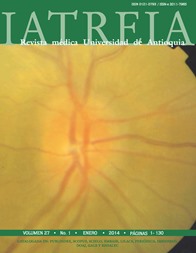Phenotypic and genotypic characterization of Salmonella Typhimurium variant 5- isolates associated with an outbreak of food-borne disease in Paz de Rio, Boyacá, Colombia, in 2010
DOI:
https://doi.org/10.17533/udea.iatreia.14327Keywords:
Epidemiologic Surveillance, Foodborne Diseases, Salmonella Typhimurium, Serotyping, Salmonella InfectionsAbstract
Introduction: Salmonella enterica serotype Typhimurium variant 5- is a pathogen closely related to animals, especially pigeons, which has been also associated in rare cases with sporadic infections in humans. However, epidemiological surveillance systems have enabled the detection of this variant in human outbreaks.
Objective: To characterize by means of phenotypic and genotypic techniques the isolates of Salmonella Typhimurium variant 5- associated with an outbreak of food-borne disease in Paz de Rio, Boyacá, Colombia (2010), in order to establish their molecular relationships.
Materials and methods: Twelve isolates of Salmonella spp., were analyzed by biochemical, serotyping and antimicrobial susceptibility tests. Pulsed-field gel electrophoresis (PFGE) with XbaI and Blnl enzymes was used to establish their molecular relationships.
Results: All isolates were confirmed as Salmonella spp. They were resistant to tetracycline and streptomycin and sensitive to the rest of antibiotics tested. Eleven isolates were identified as Salmonella Typhimurium variant 5- and grouped in COIN10.JPX.X01.0168 pattern using the enzyme XbaI; two isolates in this group were confirmed using the enzyme BlnI with the COIN10. JPX.A26.0002 pattern. One isolate was identified as Salmonella Typhimurium with COIN10.JPX.X01.0221 pattern with the enzyme XbaI.
Conclusion: This is the first outbreak in Colombia of foodborne illness epidemiologically associated with isolates of Salmonella Typhimurium variant 5 -, which were phenotypically and genetically related.
Downloads
Downloads
Published
How to Cite
Issue
Section
License
Papers published in the journal are available for use under the Creative Commons license, specifically Attribution-NonCommercial-ShareAlike 4.0 International.
The papers must be unpublished and sent exclusively to the Journal Iatreia; the author uploading the contribution is required to submit two fully completed formats: article submission and authorship responsibility.














